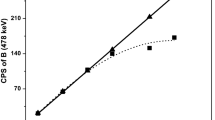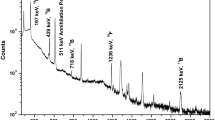Abstract
The internal mono-standard relative method has been used for compositional analysis of prompt gamma activation analysis (PGAA). PGAA is very useful for the analysis of boron elements in various sample matrices, especially in the uranium samples, which attenuates neutron intensity significantly. The concentration ratio of boron is determined relative to the uranium as internal mono-standard. The concentration of uranium is well traceable when the sample was fabricated and also measured by a relative method using certified reference material. The uranium dioxide powder samples were prepared by crushing the fuel pellets and then mixed with the adjuvant compounds to improve the combustion characteristics of the nuclear fuel. The first adjuvant compound is boron compound like boron nitride and hafnium diboride. The second adjuvant is manganese oxide, which is considered to enhance the thermal stability of the boron compounds. The elemental concentrations of the samples were measured by a thermal neutron PGAA facility at the HANARO research reactor and analyzed using a KAERI-PGAA code including a Doppler-broadened boron peak analysis (DBPA) routine for boron analysis.







Similar content being viewed by others
References
IAEA-TECDOC-1654 (2010) Advanced Fuel Pellet Materials and Fuel Rod Design for Water Cooled Reactors. International Atomic Energy Agency (IAEA), Vienna
IAEA-TECDOC-844 (1995) Characterisitcs and usd of Urania-gadolinia fuels. International Atomic Energy Agency (IAEA), Vienna
Patel KS, Sharma S, Maity JP, Ramos P, Fiket Z, Bhattacharya P, Zhu Y (2022). Front Environ Sci. https://doi.org/10.3389/fenvs.2022.1058053
Hidaka H, Masuda A, Fujii I, Shimizu H (1988). Geochem J DIO. https://doi.org/10.2343/geochemj.22.47
Watanabe S, Kumanomido H, Mitsuhashi I, Sugahara S, Ueda M (2011) Manufacturing method of nuclear fuel pellet, fuel assembly for nuclear reactor and manufacturing method thereof and uranium powder. U.S. Patent No. US 2011/0080987 A1. Washingto, DC: U.S. Patent and Trademark Office
Böhlkea S, Schuster C, Hurtado A (2008) About the volatility of boron in aqueous solutions of borates with vapour in relevance to BWR-Reactors. In: International conference on the physics of reactors 2008, PHYSOR 08. 4. 2008
Boehlke S, Schuster C, Hurtado A, Laczko G, Ohlmeyer H (2009) The relevance of boron volatility during long-term transients in a boron poisoned boiling water reactor. Inforum Verlag, Bayern
Noda N, Ito S, Nunome Y, Uekib Y, Yoshiie R, Naruse I (2013) volatilization characteristics of boron compounds during coal combustion. In: Proceedings of the combustion institute
Simon J (2004) Boron chemistry in flue gases from borosilicate glass furnace. Ceram Trans 141:389–395
Giardini AA (1953) Boron Nitride. Information Circular 7664, United States Department of the Interior
Hayens WM (2011) CRC handbook of chemistry and physics. CRC Press, Boca Raton
Wentorf R Jr (1957) Cubic form of boron nitride. J Chem Phys 26:956
Ball P (1997) Made to measure: new materials for the 21st century. Princeton University Press, Princeton
IAEA-TECDOC-813 (1993) Advances in Control Assembly Materials for Water Reactor. International Atomic Energy Agency (IAEA), Vienna
Molnár G, Belgya T, Dabolczi L, Fazekas B, Révay Z, Veres Á, Bikit I, Kiss Z, Östör J (1997) The new prompt gamma-activation analysis facility at Budapest. J Radioanal Nucl Chem 215:111–115
Sun GM, Park CS, Choi HD (2003) Performance of a compton suppression spectrometer of the SNU-KAERI PGAA facility. Nucl Eng Technol 35:347–355
Byun SH, Sun GM, Choi HD (2002) Development of a prompt gamma activation analysis facility using diffracted polychromatic neutron beam. Nucl Instrum Methods Phys Res A 487:521–529
Byun SH, Sun GM, Park HI, Choi HD (2002) Beam characteristics of polychromatic diffracted neutrons used for prompt gamma activation analysis. Nucl Eng Technol 34:30–41
Phillips GW, Marlow KW (1976) Automatic analysis of gamma-ray spectra from germanium detectors. Nucl Instrum Meth 137:525–536
Park CS, Choi HD, Sun GM, Whang JH (2008) Status of developing hpge γ-ray spectrum analysis code HYPERGAM. Prog Nucl Energ 50:389–393
Choi H-D, Jung N-S, Park B-G (2009) Analysis of doppler broadened peak in thermal neutron induced 10B(n, α γ)7Li reaction using HYPERGAM. Nucl Eng Technol 41:113–124
IAEA-TECDOC-619 (1991) X-ray and Gamma-ray Standards for Detector Calibration. International Atomic Energy Agency (IAEA), Vienna
Chu S (1999) The Lund/LBNL Nuclear Data Search. https://nucleardata.nuclear.lu.se/toi/
Sun GM, Park CS, Choi HD (2008) Doppler-broadened boron peak analysis by using a modified spectral decomposition algorithm. J Radioanal Nucl Chem 278(3):637–642
Acknowledgements
We really appreciate Uranium dioxide samples were supplied by Dr. Rhee Young Woo, KAERI. This work was supported by the National Research Foundation of Korea (NRF) and grant funded by the Korea Atomic Energy Research Institute (KAERI) [NRF-2017M2A2A6A05018529 and Grant No. 521410-23, South Korea]. This study was presented at the International Conference on Nuclear Analytical Techniques in 2022 (NAT2022), which was held in Daejeon, Korea, from Dec. 7 to 9, 2022.
Author information
Authors and Affiliations
Corresponding author
Additional information
Publisher's Note
Springer Nature remains neutral with regard to jurisdictional claims in published maps and institutional affiliations.
Rights and permissions
Springer Nature or its licensor (e.g. a society or other partner) holds exclusive rights to this article under a publishing agreement with the author(s) or other rightsholder(s); author self-archiving of the accepted manuscript version of this article is solely governed by the terms of such publishing agreement and applicable law.
About this article
Cite this article
Kang, M.Y., Lee, J.G. & Park, B.G. Analysis of mixture samples of uranium dioxide and boron compounds by using thermal neutron prompt gamma activation analysis. J Radioanal Nucl Chem 332, 5267–5272 (2023). https://doi.org/10.1007/s10967-023-09183-x
Received:
Accepted:
Published:
Issue Date:
DOI: https://doi.org/10.1007/s10967-023-09183-x




